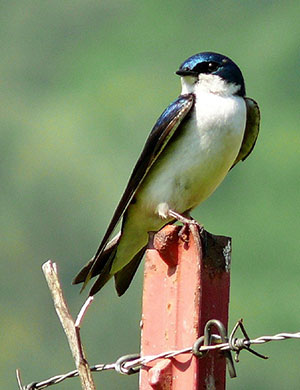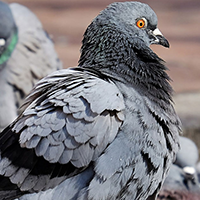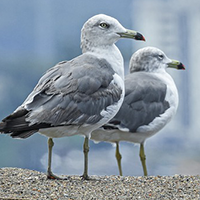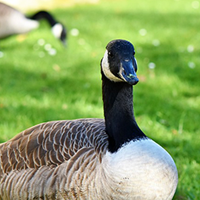 Unlike the bank swallow, the tree swallow is not considered a threatened species, although they are still a protected species under the Migratory Birds Convention Act like all swallows in Canada. Many projects are in place that work to provide sufficient housing for tree swallows in high population areas to prevent these swallows acting as a pest and nesting in unwanted places. But that being said areas like construction sites and farms may consider these birds as pests because they may be nesting in unwanted areas. The best option for tree swallows is to provide alternative housing such as nesting boxes in a nearby area with a suitable habitat to encourage the swallows to nest in this more favourable area.
Unlike the bank swallow, the tree swallow is not considered a threatened species, although they are still a protected species under the Migratory Birds Convention Act like all swallows in Canada. Many projects are in place that work to provide sufficient housing for tree swallows in high population areas to prevent these swallows acting as a pest and nesting in unwanted places. But that being said areas like construction sites and farms may consider these birds as pests because they may be nesting in unwanted areas. The best option for tree swallows is to provide alternative housing such as nesting boxes in a nearby area with a suitable habitat to encourage the swallows to nest in this more favourable area.
What Hawkeye can do to help?
Hawkeye is known for our use of falconry and work with swallows is no different. Our main go to preventative solution is falconry and birds of prey. Using hawks and falcons Hawkeye can effectively encourage tree swallows on your property to nest elsewhere as our flying birds create an unsafe environment for these birds to raise their young. This service must be done by a professional. Contact Hawkeye today at 416-429-5393 for your own personalized swallow solution.
Range and Habitat
The tree swallow can be seen all over North America in the spring, summer, and fall during their breeding season. But come winter time, the tree swallows migrate out of Canada and the upper states towards the Atlantic coast until the following spring. You can find tree swallows around creeks, lakes, marshes, swamps, fields, and shorelines across Ontario.
Physical Attributes
The tree swallow is quite distinctive in the light with its iridescent turquoise blue back, nape, and crown. Many people are unaware that not all feather colours on birds are pigmented; you may even be confused as to what that means. Basically, birds can be coloured in two different ways. One is pigmented, meaning the colour is consistently the same regardless of the lighting. The other form of colour is iridescence. If you are an avid bird watcher you may have noticed some birds shine with bright colours in the right light, this is due to a nanostructure on the feathers of the birds that interacts directly with light to create an array of potential colours. This nanostructure is created out of keratin and melanosomes and is truly an incredible feature that makes some birds very unique. The light passes through very small barbules, that cannot be seen with the naked eye, and refracts off this keratin based structure similar to that of a prism, absorbing all the colours except the colour you see on the feathers. For example, the feathers of a cardinal are pigmented, red is red is red, they will always look the same regardless of the light involved, where birds such as barn swallows, tree swallows, grackles, and certain parts of the blue jay all sport these iridescent feathers. To identify other parts of the tree swallow you can look for a white throat, breast, and belly and brown wings and tail.
Nesting and Diet Habits
As previously mentioned, many projects work on building nest boxes for tree swallows to help the population from declining, but normally tree swallows will nest in the tree cavities of dead trees. They are infamous for using a cavity that has been abandoned by other birds such as woodpeckers. Tree swallow nests are often made of whatever can be found in the surrounding area, but mostly consist of grass, pine needles, mosses, and the feathers of other birds. Like all other swallows, the female forms the nest into a cup like shape perfect for laying her eggs. She then lies between 4 and 7 eggs which must be incubated between 10 and 20 days. When tree swallow eggs are first laid, they are pale pink in colour, fading to pure white within a week of being laid and do not get larger than 2 cm in any direction. This changing colour feature is a good identifier to help determine how long these eggs have been in the nest. Like all swallows, the diet of the tree swallow consists almost entirely of small insects including flying insects like flies, bees, and dragon flies and ground insects like spiders, and roundworms.
















